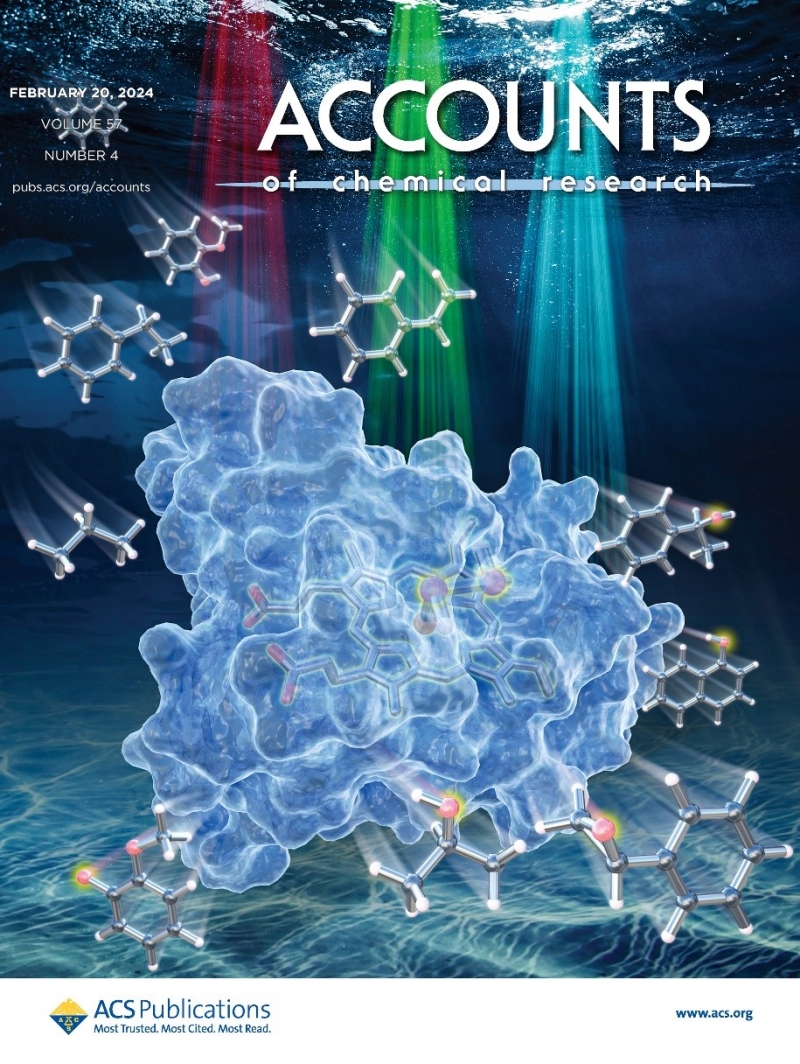From monooxygenases to peroxizymes: recent progress in enzyme engineering of cytochrome P450s
Cytochrome P450 monooxygenase is a versatile oxidizing enzyme with great potential in synthetic chemistry and biology.
Recently, a team led by Prof. Zhiqi Cong from the Institute of Bioenergy and Bioprocess Technology (QIBEBT) of the Chinese Academy of Sciences was invited to summarize its progress in transformation of natural NAD(P)H-dependent P450 monooxygenases into their peroxizyme modes, providing an alternative approach to improve the practical catalytic potential of P450 in vitro.
This study published in Accounts of Chemical Research as supplementary cover article on January 31, 2024.
This study includes three emerging strategies developed by Cong’s team, i.e., the strategy of dual-functional small molecule (DFSM)for generating the peroxygenase activity of P450BM3 monooxygenase, strategy of redox-sensitive residues engineering for modulating the peroxidase vs peroxygenase activity in P450 enzymes, and tunnel engineering approach of H2O/H2O2 to enable peroxygenase activity in P450 monooxygenases.
In DFSM strategy, the typical DFSM, such as N-(ω-imidazolyl)-hexanoyl-L-phenylalanine (Im-C6-Phe), binds to the fatty acid hydroxylase P450BM3 enzyme with an anchoring group at one end and plays a general acid-base catalytic role in the activation of H2O2 with an imidazolyl group at the other end. The introduction of DFSM efficiently enables the heterolytic O-O cleavage of the adduct Fe-O-OH, which is favored for the formation of active species compound I than the O-O homolysis mechanism in the absence of DFSM according to crystallographic evidence and theoretical calculations. Furthermore, optimizing the anchoring group of DFSMs by introducing the dipeptide moiety substantially improves their binding affinity to P450BM3 and potentials of practical application, while diversifying the catalytic group of DFSM with pyridine or amino group to replace imidazole greatly enriches the catalytic function and selectivity of P450 peroxygenase. Most importantly, the DFSM-facilitated P450 peroxygenases have showed the unique catalytic performance for the highly difficult selective oxidation of C-H bonds, e.g., chemoselective hydroxylation of gaseous alkanes, regioselective O-demethylation of aryl ethers, highly (R)-enantioselective epoxidation of styrene, and regio- and enantiomerically diverse hydroxylation of alkylbenzenes.
Next, researchers demonstrated that DFSM-facilitated P450BM3 peroxygenase could be effectively switched to the efficient peroxidase mode through mechanism-guided protein engineering of redox-sensitive residues, paving the way to access the direct nitration of unsaturated hydrocarbons such as phenols, aromatic amines, and styrene derivatives. This is not only the first example of P450-catalyzed direct nitration of phenols and aromatic amines, but also the first report of the direct biological nitration of olefins.
According to the structural analysis of natural and engineered peroxygenases, researchers proposed a novel tunnel engineering strategy of H2O/H2O2 for the first time, which was demonstrated to be quite useful for enabling peroxygenase activity in different NAD(P)H-dependent P450 monooxygenases. This may become a general method for accessing engineered peroxygenases from P450 monooxygenases.
Despite possible certain limitations, these emerging strategies provides toolkits to generate or modulate the peroxizymes activity of P450 monooxygenases, feasibly expanding the scope of P450 chemistry and catalysis. It is expectable to open a new avenue for the development of new P450-based biological enzyme catalysts to contribute to synthetic biology and green biological manufacturing.

(Image/Text by CONG Zhiqi)
Contact:
KONG Fengru
Qingdao Institute of Bioenergy and Bioprocess Technology, Chinese Academy of Sciences
Tel: 86-532-58261072
E-mail: kongfr@qibebt.ac.cn